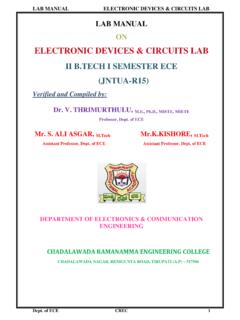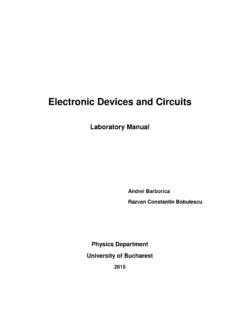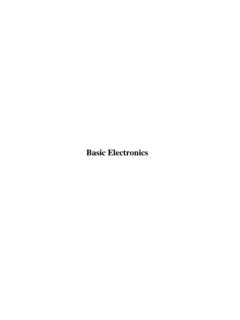Transcription of About the Tutorial - Current Affairs 2018, Apache …
1 electronic Circuits i About the Tutorial This Tutorial explains the very basic circuits in Electronics and Communications. The circuits mentioned in this Tutorial are mostly related to the applications of diodes. The components mentioned in Basic Electronics Tutorial have their applications seen here. Almost all the important diode circuits are covered in this Tutorial . Audience This Tutorial is intended for beginners in the field of Electronics and Communications and hence, it would be useful for most students. It has been designed keeping in mind the requirements of beginners who are interested in learning the functionalities of basic circuits used in Electronics and Communication. Prerequisites The readers should have elementary knowledge regarding electronic components to make the most of this Tutorial , however it is not a necessity. If you want to refresh your knowledge on the construction, working, and applications of electronic components, then please go through our Basic Electronics Tutorial first.
2 Disclaimer & Copyright Copyright 2017 by tutorials Point (I) Pvt. Ltd. All the content and graphics published in this e-book are the property of tutorials Point (I) Pvt. Ltd. The user of this e-book is prohibited to reuse, retain, copy, distribute or republish any contents or a part of contents of this e-book in any manner without written consent of the publisher. We strive to update the contents of our website and tutorials as timely and as precisely as possible, however, the contents may contain inaccuracies or errors. tutorials Point (I) Pvt. Ltd. provides no guarantee regarding the accuracy, timeliness or completeness of our website or its contents including this Tutorial . If you discover any errors on our website or in this Tutorial , please notify us at electronic Circuits ii Table of Contents About the Tutorial .. i Audience .. i Prerequisites.
3 I Disclaimer & Copyright .. i Table of Contents .. ii 1. electronic Circuits Introduction .. 1 electronic Components .. 1 electronic Circuits .. 2 2. electronic Circuits Signals .. 5 Types of Signals .. 5 Signals & Notations .. 6 WAVE 13 3. electronic Circuits Linear Wave shaping .. 14 Types of Wave 14 Filters .. 14 Low Pass Filter .. 15 High Pass Filter .. 17 Band Pass Filter .. 18 Band Stop Filter .. 20 4. electronic Circuits Special Functions of LPF and HPF .. 22 Low Pass Filter as Integrator .. 22 High Pass Filter as Differentiator .. 24 5. electronic Circuits Nonlinear Wave Shaping .. 26 6. electronic Circuits Positive Clipper Circuits .. 27 Positive Shunt 29 7. electronic Circuits Negative Clipper Circuits .. 32 Negative Series Clipper .. 32 Negative Shunt Clipper .. 34 Two-way Clipper .. 36 8. electronic Circuits Clamper Circuits .. 38 Clamper circuit .
4 38 Types of Clampers .. 38 Positive Clamper circuit .. 39 Positive Clamper with Positive Vr .. 39 Positive Clamper with Negative Vr .. 40 Negative Clamper .. 41 Negative clamper with positive Vr .. 41 Negative Clamper with Negative Vr .. 42 Applications .. 42 electronic Circuits iii 9. electronic Circuits Limiter & Voltage Multiplier .. 43 Limiters .. 43 Voltage Multipliers .. 45 Voltage Divider .. 47 10. electronic Circuits Diode as a Switch .. 49 Working of Diode as a Switch .. 49 Diode Switching Times .. 50 POWER SUPPLIES .. 55 11. electronic Circuits Power Supplies .. 56 Need for Power Supplies .. 56 Parts of a Power supply .. 57 Block Diagram of a Power Supply Unit .. 57 Transformer .. 57 Step-Up Transformer .. 59 Step-Down Transformer .. 60 12. electronic Circuits Rectifiers .. 61 Rectification .. 61 Half-Wave Rectifier .. 62 Analysis of Half-Wave Rectifier .. 63 13.
5 electronic Circuits Full Wave Rectifier .. 70 Center-tapped Full-Wave Rectifier .. 70 Bridge Full-Wave Rectifier .. 73 Working of a Bridge Full-Wave Rectifier .. 73 Waveforms of Bridge FWR .. 74 Analysis of Full-Wave Rectifier .. 75 Half-Wave vs. Full-Wave Rectifier .. 79 14. electronic Circuits Filters .. 80 Why Do We Need Filters? .. 80 Series Inductor Filter .. 81 Shunt Capacitor Filter .. 81 L-C Filter .. 81 - Filter (Pi filter) .. 82 15. electronic Circuits Regulators .. 83 Need for a Regulator .. 83 Types of Regulators .. 83 Zener Voltage Regulator .. 84 Transistor Series Voltage Regulator .. 86 Transistor Shunt Regulator .. 87 IC 88 16. electronic Circuits SMPS .. 91 Linear Power Supply .. 91 Switched Mode Power Supply (SMPS) .. 92 electronic Circuits 4 In Electronics, we have different components that serve different purposes. There are various elements which are used in many types of circuits depending on the applications.
6 electronic Components Similar to a brick that constructs a wall, a component is the basic brick of a circuit . A Component is a basic element that contributes for the development of an idea into a circuit for execution. Each component has a few basic properties and the component behaves accordingly. It depends on the motto of the developer to use them for the construction of the intended circuit . The following image shows a few examples of electronic components that are used in different electronic circuits. Just to gather an idea, let us look at the types of Components. They can either be Active Components or Passive Components. Active Components Active Components are those which conduct upon providing some external energy. Active Components produce energy in the form of voltage or Current . 1. electronic Circuits Introduction electronic Circuits 5 Examples: Diodes, Transistors, Transformers, etc.
7 Passive Components Passive components are those which start their operation once they are connected. No external energy is needed for their operation. Passive components store and maintain energy in the form of voltage or Current . Examples: Resistors, Capacitors, Inductors, etc. We also have another classification as Linear and Non-Linear elements. Linear Components Linear elements or components are the ones that have linear relationship between Current and voltage. The parameters of linear elements are not changed with respect to Current and voltage. Examples: Diodes, Transistors, Transformers, etc. Non-linear Components Non-linear elements or components are the ones that have a non-linear relationship between Current and voltage. The parameters of non-linear elements are changed with respect to Current and voltage. Examples: Resistors, Capacitors, Inductors, etc.
8 These are the components intended for various purposes, which altogether can perform a preferred task for which they are built. Such a combination of different components is known as a circuit . electronic Circuits A certain number of components when connected on a purpose in a specific fashion makes a circuit . A circuit is a network of different components. There are different types of circuits. The following image shows different types of electronic circuits. It shows Printed circuit Boards which are a group of electronic circuits connected on a board. electronic Circuits 6 electronic circuits can be grouped under different categories depending upon their operation, connection, structure, etc. Let s discuss more About the types of electronic Circuits. Active circuit A circuit that is build using Active components is called as Active circuit . It usually contains a power source from which the circuit extracts more power and delivers it to the load.
9 Additional Power is added to the output and hence output power is always greater than the input power applied. The power gain will always be greater than unity. Passive circuit A circuit that is build using Passive components is called as Passive circuit . electronic Circuits 7 Even if it contains a power source, the circuit does not extract any power. Additional Power is not added to the output and hence output power is always less than the input power applied. The power gain will always be less than unity. electronic circuits can also be classified as Analog, Digital, or Mixed. Analog circuit An analog circuit can be one which has linear components in it. Hence it is a linear circuit . An analog circuit has analog signal inputs which are continuous range of voltages. Digital circuit A digital circuit can be one which has non-linear components in it. Hence it is a non-linear circuit .
10 It can process digital signals only. A digital circuit has digital signal inputs which are discrete values. Mixed Signal circuit A mixed signal circuit can be one which has both linear and non-linear components in it. Hence it is called as a mixed signal circuit . These circuits consist of analog circuitry along with microprocessors to process the input. Depending upon the type of connection, circuits can be classified as either Series circuit or Parallel circuit . A Series circuit is one which is connected in series and a parallel circuit is one which has its components connected in parallel. Now that we have a basic idea About electronic components, let us move on and discuss their purpose which will help us build better circuits for different applications. Whatever might be the purpose of an electronic circuit (to process, to send, to receive, to analyze), the process is carried out in the form of signals.



















